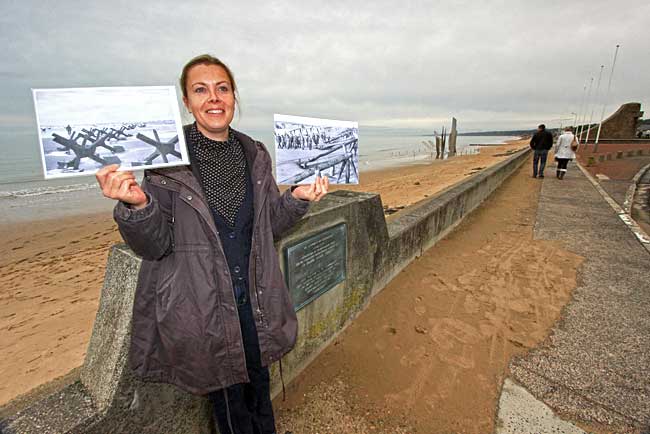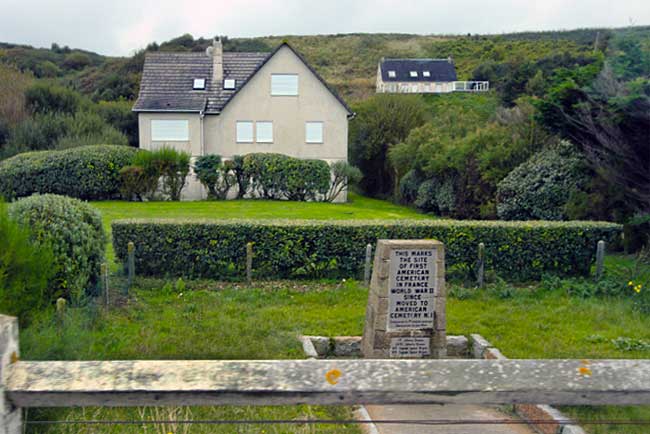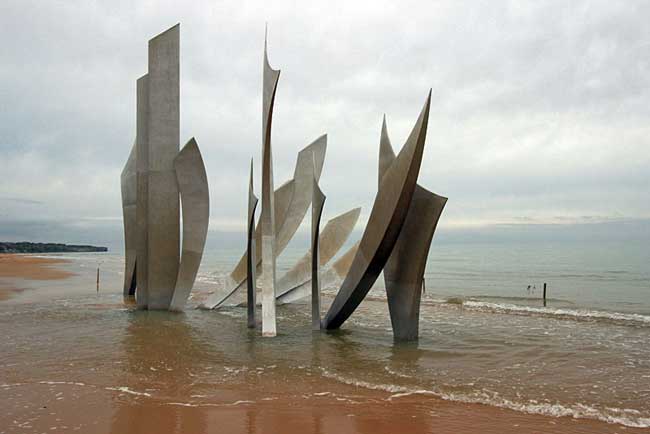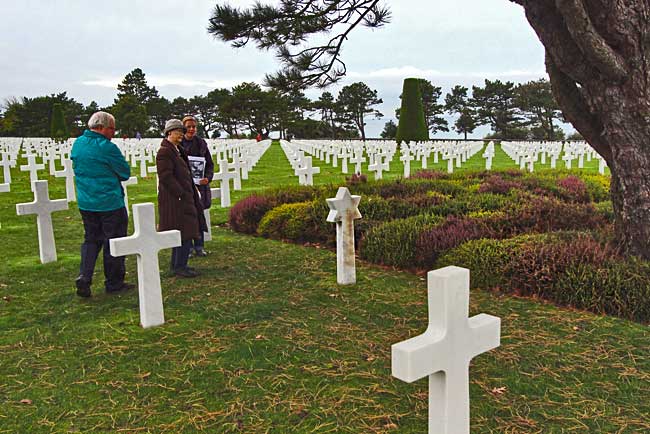Shivering in the blustery October winds, I pulled my sweatshirt up around my ears and gazed over the historic Omaha Beach in Normandy, France. Children played tag with the undulating tide and couples strolled hand-in hand. In the distance, a few tourists clustered around “Les Braves,” a remarkable sculpture by artist Anilore Ban that sweeps its balletic stainless steel wings skyward in commemoration of the more than 4,000 Allied troops who lost their lives on that fateful day in 1944.
My guide from the Mémorial de Caen Museum, Rosine Champion, held up photos of the giant rolls of barbed wire and semi-submerged iron hedgehogs that Germans installed on Omaha Beach during World War II.
“It’s hard to believe that this was a site of such carnage,” I remarked.

Champion pointed to an unassuming cottage on the opposite side of the road, tucked between sand dunes crowned with dense vegetation. “That’s the only house on Omaha Beach that survived the Normandy invasion,” she explained.” Gradually, families rebuilt and these days Omaha Beach is a very popular vacation spot with the French.”

I looked around, but saw none of the signs of a typical seaside resort town. “I don’t see any hotels or restaurants or tacky gift shops.”
“We have a saying in France,” Champion replied. “We don’t profit on the backs of the dead.”
I broke out in goosebumps. Out of respect for the role it played in World War II, Omaha Beach has intentionally not been commercialized. It was one of many astonishing things I would learn during my half-day tour of the Normandy beaches. Two weeks earlier I had arrived in Paris, expecting ill treatment, as I’d always heard that the French are not particularly fond of Americans. Quite the opposite, I’d been treated with nothing but genuine kindness, which I found mystifying in light of the fact that American bombs had decimated many of the French coastal towns during the war. I pressed this point with Champion: “I understand that bombers sent to destroy bridges and railroads during the Normandy invasion missed their mark, instead destroying the nearby town of Caen. How do the French feel about that?”

“We know you had no choice. My grandfather says if you did not do this we would be speaking German today.”
The sense of incongruity grew stronger with Normandy Beach site we visited. At Pointe de Hoc I followed meandering trails through lush grass to a series of abandoned concrete bunkers that had contained 155mm cannons. On D-Day, the 2nd Ranger battalion scaled the 98-foot high cliffs using using rope ladders and grappling hooks while under heavy fire, suffering 60% casualties during the initial assault and the following two days. Yet on the day I visited, it was a picture of serenity; turquoise waters lapped the rocky cliffs and a fishing boat puttered by just offshore.
Cant view the above slideshow of the WWII Normandy Beaches in France? Click here.
At Utah Beach I explored the dark inner recesses of German casemates, where enormous anti-tank artillery guns were quietly rusting away. Just beyond Gold Beach I followed a clifftop trail past a bomb crater for a view of the town of Arromanches. Its pretty little bay is still ringed by Mulberry harbors, artificial docks set into deep water to facilitate offloading the thousands of troops and tons of equipment needed to support the Allied invasion.

Our final stop was the Normandy American Cemetery and Memorial. On a hilltop overlooking Omaha Beach, 9,387 white marble crosses marked the graves of American soldiers who were killed during the D-Day Landings and the Battle of Normandy. Some crosses were engraved with the names of soldiers but many simply carried the inscription: “Here Rests in Honored Glory a Comrade in Arms Known But to God.”
Interspersed among the rivers of crosses were a handful topped by the Star of David. Considering the horrors of the Holocaust, the mingling of christian and Jewish graves maybe the most appropriate memorial of all. I wandered up and down the perfectly manicured rows, thinking about my father, who was a lower-ball gunner in a B-17 bomber during World War II. It was one of the most dangerous places in a bomber but Dad was one of the lucky ones – he made it home. How I wished he could have been there with me, but at 87-years old he says his traveling days are over. So I did the next best thing. I stood in the center of the cemetery, looked over the sea of crosses to the steely gray ocean, and silently paid my respects – for both of us.

Another place for me to visit. I’m impressed that the French have commercialized this area….. good on them.
Your writing inspires me to add this to my list.
In Budapest I was moved to tears at some of the sites we visited.
It was a very emotional destination for me Irene. My Dad was in WWII, a gunner in a B-17, so I always get choked up at these places.
Hi Barbra, I would love to contact you for more information regarding your tour. I am going to France this fall and I want to visit as many of the historic beaches as I can. I have many many questions. I will list some,
What tour did you use?
Is it still offered?
Where did the tour take you?
Where did you meet at to start the tour?
Would you recommend it or a different one?
Hi Nicole: I don’t run any tours myself. I’m simply a travel writer. I tell stories about the places I’ve been and the people I meet. In this case, I booked a day tour through Mémorial de Caen Museum, as I stated in the original article you read. I have no idea if the exact tour is still offered, but if not, I’m sure they will have something similar. Check out their website (the link to it is in my article) for additional details and book directly with the museum. I highly recommend a visit to the museum and I’m sure all of the tours they offer are as excellent as the one I took.
I love that statue, planted among the waves – it’s such a powerful expression. And what a lovely thing, to have not turned commercial here. bravo!
I loved that sculpture too, Jessie!
Barbara, this post made me cry. So beautiful. Living in Germany, I had to take a class (in conjunction with my language class) about the German government, history, etc. and it’s so interesting to learn a little more about WWII, especially from this perspective. They’re not shy about pointing out how horrible their country was all those years ago. Thanks for sharing your experiences at Normandy.
We didn’t see the museum at Caen, but really thought the one at Arromanches was fantastic, especially the film the British made while the war was still going on, that told of building the complete harbor in secret in England and then bringing it to the site towed behind ships. We also learned that there are relatively few Stars of David amongst the crosses because the families had the choice of having the remains of their men brought back to the USA. Relatively few did, except for the Jewish families who had cultural/religious reasons that they wanted the remains brought home. So the professional of Jewish soldiers was much higher than is reflected in the cemetery.
I hadn’t really thought about that Dan but it makes a lot of sense. Thanks so much for sharing your information.
I felt really moved standing among thousands of war dead in a beautifully maintained Australian cemetery in Villers-Brettoneux (near Amiens). Not another sole in sight and around 8:30am on a slightly misty morning, I couldn’t help but read stone after stone of people in their early 20s, quite a few marked as unknown. The memories are still vivid today as I read your fine article.
Thanks, Mark, for your heartfelt comment. I was so impressed by the way the French have honored those who fought on their behalf.
Beautiful post Barb. I was lucky enough to trod the same ground you did for this post, but 15 years ago. Sometimes I give the French some stick politically, but this is one place they’ve really done it right. My dad was in the second wave of the assault on Omaha Beach, so visiting there was an enormously moving experience for me and you have captured it well here. Thanks and good job.
Greg, your comment means a great deal to me. Thanks so much for taking the time to put your thoughts down. It was very emotional for me, too, and when I read it to Dad (staying with him at the moment because he just had surgery), I couldn’t get through it without tearing up.
What a lovely reminder of what we have to be thankful for – my husband was in the army so I always find visiting these war memorials and battle sites very moving
It was so moving for me Heather – I actually cried when I wrote this!
I had a similar experience last spring visiting Juno Beach, the Juno Beach Centre and the Canadian War Cemetery with my children. It is nice that the French have preserved the area as a place to pay respects rather than commercializing it. What struck me the most at the cemetery was the ages of many of the young men who lost their lives. So many of them not much older than my teenage daughter and her friends – and unimaginable to me to think of sending them off to war.
Hi Lisa: Yes, completely unimaginable. But I guess the military needs young people to fight the wars because, as my father says, when you’re that age you think you’re invincible. Of course, it would be better to not have war at all, but sadly the world hasn’t figured out how to do that yet.
Great post! I must say though that the sculpture in the beach looks really cool.
Hi Jam: The “Les Braves” sculpture was incredibly beautiful and I found it remarkable that it is installed in the sand, with waves lapping at thee base.
Hi Barbara. Thought I would just say, I really enjoyed this one. Hope you are well. Nate.
Thank you Nate! I appreciate your comment more than you know. It was a very emotional post for me to write but I think it truly conveys what I felt.
This is a really nice post! We found the American Cemetery at Normandy to be incredibly moving. You really did justice to the whole experience. Our one great disappointment was actually the Mémorial de Caen Museum. Being so far inland and set up against an office park, it didn’t really capture of the aesthetic of D-day and the place. Great post! Glad I found your blog.
Thanks so much Lance! The location and exterior of the museum left me a bit cold as well, but I found the displays within fascinating and very well done. So glad you enjoyed my article and my blog, and I appreciate you taking the time to let me know.